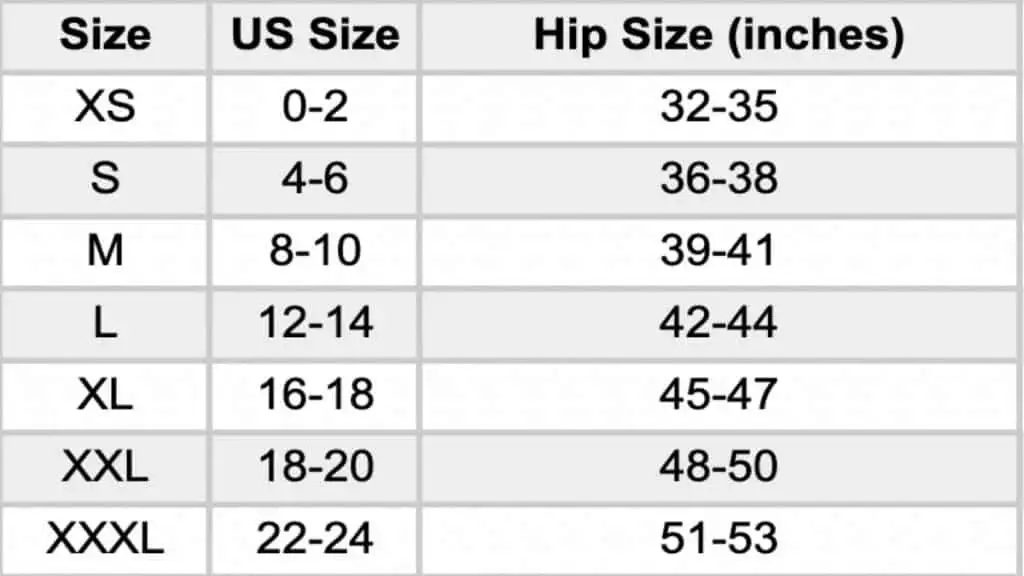If you have 44 inch hips, then that could mean a few different things: You might have muscular glutes? Perhaps you store a lot of your body fat around your hips? Or maybe you have wide hip bones?
Of course, many people have a 44 inch butt due to a combination of factors. So if you want to learn all the pros and cons of having 44″ hips, then keep reading to get the full lowdown.
Related Hip Measurement Guides:
- How to measure your hips
- 40 inch booty
- 41 inch booty
- 42 inch booty
- 43 inch booty
- 45 inch booty
- 46 inch booty
- 47 inch booty
- 48 inch booty
- 49 inch booty
How big are 44 inch hips for women?

Are 44 inch hips big for a woman? Yes, 44 inch hips are definitely big for women and are an indication that you have a lot of glute muscle and/or that you store a lot of your fat around your hips.
This is echoed by anthropometric research, which confirms that 44″ hips are definitely large for a female. Indeed, if you have a genuine 44 inch booty, then you definitely don’t have a medium sized butt.
Most women don’t have 44 in hips, and it’s very unlikely that you’d have 44 inch hips purely due to your well-developed glutes. Rather, you’d likely need a fair bit of body fat around your hips (which is completely normal) in order to achieve a 44 inch hip size.
Now, what’s really important to consider when you’re deciding just how big your 44 butt really is, is the size of your waist. If you have a narrow waist and 44″ hips, then you definitely have a low waist-to-hip ratio (WHR).
Not only does having a low WHR increase your chance of having a highly desirable hourglass figure, but many research papers have shown that having a low WHR is protective against disease.
One study, for example, showed that obesity, as assessed by waist-to-hip ratio, is a better predictor of cardiovascular and heart disease mortality than obesity assessed by BMI or the size of your waist alone. [1] So if you want to live a long and healthy life, then it’s likely very beneficial to store fat on your hips rather than around your waist.
How large are 44 inch hips for men?

How big are 44 inch hips for men? According to US measurement data, 44 inch hips are 5 inches bigger than average for an adult male. So if you have 44″ hips as a man, then your hips will likely be one of the most prominent body parts on your physique.
But considering that women typically have bigger hips than men, what could cause a man to have 44 in hips—hips that are very large even for a woman?
The most obvious reason is excess body fat. It’s very easy for your body to accumulate fat tissue (it’s way easier than adding new muscle mass). So easy, in fact, that being overweight, while definitely undesirable, is actually the norm nowadays.
Add in a genetic predisposition to store fat around your hips, and you can see how it’s possible for your hip circumference to increase significantly.
Another reason why a man might have a 44 inch butt is due to him having muscular glutes. The glutes, after all, are the biggest and strongest muscle on your body. So when you increase your squat and hip thrust weight, your glutes are bound to respond by getting larger. That’s just how lifting weights works.
What size are 44 inch hips?

What clothing size are 44 inch hips? It really depends on the brand and the type of clothing. But, according to my sizing research, a 44 inch waist often works out at a women’s size large, which is equal to a US size 12-14.
Is a 44 inch butt too big?

It depends. If your 44 inch butt is accompanied by a large waist, then that’s an indication that you need to lose weight because you have a high waist-to-hip ratio.
On the other hand, if you have a slim waist and 44 inch hips, then you likely have nothing to worry about unless you have a high BMI.
Of course, some people who have a 44 inch booty due to genetic glute muscularity or a tendency to store fat on their hips don’t actually like the way that their 44 inch butt looks. If this is you, then I recommend performing plenty of cardiovascular exercise so that you can burn calories, lose weight, and achieve that reduction in glute size that you’re after.
Conversely, many people would actually love to have 44 inch glutes.
So, in summary, whether or not a 44 inch hip size is too big mainly depends on the size of your waist and the kind of body that you want to build.
How can you build a 44 inch booty?

Obviously, the best way to build a 44 inch booty is to train your glutes with weights, ideally 2-4 times per week. But to get the best results, you need more than just raw effort.
At a minimum, you need to do one exercise where your glutes are stretched (squats or split squats), one exercise where your glutes are contracted (hip thrusts or glute bridges), and one exercise that involves hip abduction.
While bodyweight exercises and light workouts have their place, the glutes respond excellently to heavy, fiber-tearing tension. Indeed, research shows that athletes who rely on their glutes for performance (powerlifters, high jumpers, soccer players) have bigger glutes than athletes who don’t use their glute strength as much during their particular sport (e.g., swimmers and endurance runners). [2]
So if playing a particular sport can build your glutes, just imagine how much size you can gain by dedicating yourself to a specific glute training regime!
Of course, not everyone has the genetics to build a 44 inch butt without getting fat. So instead of focusing on specific circumference measurements, I recommend training consistently and letting the results and inches take care of themselves.
In conclusion: Is having a 44 inch hip size good or bad?

Having 44 inch hips isn’t bad unless your hip size is indicative of some kind of problem (e.g., that you’re overweight).
In and of itself, there’s nothing wrong with having 44 in hips and, as I’ve spoken about elsewhere, having large hips and a comparatively narrow waist might actually be protective against certain chronic diseases.
References
- Welborn, T. A., Dhaliwal, S. S., & Bennett, S. A. (2003). Waist–hip ratio is the dominant risk factor predicting cardiovascular death in Australia. Medical Journal of Australia, 179(11), 580–585. https://doi.org/10.5694/j.1326-5377.2003.tb05704.x
- Niinimäki, S., Härkönen, L., Nikander, R., Abe, S., Knüsel, C., & Sievänen, H. (2016). The cross-sectional area of the gluteus maximus muscle varies according to habitual exercise loading: Implications for activity-related and evolutionary studies. Homo : internationale Zeitschrift fur die vergleichende Forschung am Menschen, 67(2), 125–137. https://doi.org/10.1016/j.jchb.2015.06.005

